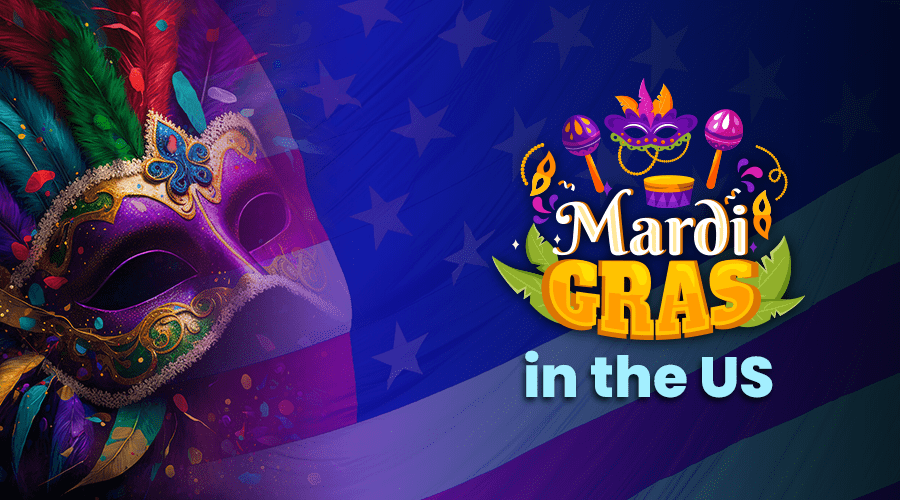History of Mardi Gras and Traditions in the US

Mardi Gras is a Carnival celebration and is widely celebrated each year all around the Christian world. It’s a major Christian holiday and a popular cultural phenomenon that dates thousands of years. In the US, New Orleans might be the biggest Mardi gras celebration and it attracts around 1.4 million visitors every year. But other cities celebrate Mardi Gras as well with different activities and it might be celebrated on different days in different regions.
Thousands of people attend the Mardi Gras parades every year wearing colorful costumes and wigs. The parades also include large decorated vehicles and crafts making the parade one of the most enjoyable events in the US.
Most probably you also join the Mardi Gras parade each year with friends and family to celebrate this Christian Carnival. But do you know the history of Mardi Gras? When and how did it start? How are different parts of the Christian word used to celebrate the Carnival for thousands of years? This blog is primarily focused on that, so that you may know the history of Mardi Gras before joining the parade this year.
What is Mardi Gras?

Mardi Gras is a Christian holiday and a carnival celebration starting on or before the Christian feasts of Epiphany (Three Kings Day) and it is widely celebrated in the US and other Christian countries of the world. Thousands of men women and kids attend huge parades on the day.
Mardi Gras is a French word that means ‘Fat Tuesday’. Mardi in French means ‘Tuesday’ and Gras means ‘Fat’. It’s the last night of enjoying rich food and all the luxuries before the ritual of Lenten sacrifices and fasting of the Lenten starts. Mardi Gras is also known as Shrove Tuesday, Pancake Tuesday, or Carnival Day in other parts of the world.
When is Mardi Gras Celebrated?

Mardi Gras was usually celebrated on ‘Fat Tuesday’, the day before Ash Wednesday as a ritual before Lent. However, it has become a festival today, and in some cities, the Mardi Gras Carnival begins weeks before Ash Wednesday.
Because of the COVID-19 pandemic, this festival got canceled for two consecutive years, 2020 and 2021. People in different cities started celebrating the event in 2022 again. The calendar date of Mardi Gras changes almost every year but it starts on the last night of Christmas which begins Epiphany. In some cities, the festival is celebrated the entire period from Twelfth Night to Ash Wednesday.
History of Mardi Gras

If we want to talk about the history of Mardi Gras, the celebration of the event first began hundreds of years ago during the Medieval times in Europe. As we already said, the day was called by different names in different parts of the world and the French and Italians first started feasting on that day with other traditional rituals. Today we know Mardi Gras as a Christian event and we’ll mainly focus on that but pagans across the world celebrated different festivals in the spring long before the Christians. They used to celebrate various spring and fertility rites which included collective celebration, feasting, and debauchery of all sorts.
The Christian Mardi Gras was first celebrated by the French and The Italians and brought to the New World by the French mostly.
The First Mardi Gras in the US
The history of Mardi Gras in the US can be dated back to the seventeenth century. French-Canadian explorer Jean-Baptiste Le Moyne de Bienville reached the shore of present-day New Orleans, Louisiana (some historians say he first landed on the shore of Mobile, Alabama) on the day of Fat Tuesday and named the place ‘Pointe du Mardi Gras’ in honoring the day. This is seen as the first celebration of Mardi Gras in the US.

Day by day he established a Christian community there and they started to celebrate the festival regularly. Over time, the celebration that began on the Pointe du Mardi Gras became widespread among the people and became a major event. There were parades and parties at that time as well but obviously, those were not like the parades and parties we celebrate today.
Evolution of the Mardi Gras Holiday
From Pointe du Mardi Gras, the celebration slowly spread out to other regions and among other people around the country. The street parties and parades continued until the Spanish overtook New Orleans in the 1760s and they shut down the ceremony as they took it as a deprave celebration. The restriction on the celebration of Mardi Gras lasted until the 1800s when the US government took over that region. During 1800-1837 Mardi Gras was recognized but not celebrated and after that, it started being celebrated widely again.
After years of restriction and suppression, the first official Mardi Gras parade took place in 1837. It was a huge parade and the celebration began to be popular among people again every year. People of all ages wearing colorful costumes, wigs, and beads attended the parades and parties.
In 1857, six men established a secret society called the Mistick Krewe of Comus. The Mistick Krewe of Comus held a themed parade each year onward to reinvigorate the holiday in the US. It is the oldest and most notable organization that has continuously been celebrating Mardi Gras in New Orleans, Louisiana.
Mardi Gras is one of the biggest parades in the US. Various street parties and feasts are also organized in different societies. You have to understand that the event and the theme have changed enormously in times and now Mardi Gras became a popular celebration among all people around the world. And if you are planning to attend the parade this year, you need to start preparing long ago because you’ll be needing some fancy costumes to go with the flow. You can check it out online or at your local vendors for Mardi Gras costumes, wigs, laces, beads, and other accessories.





